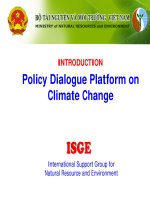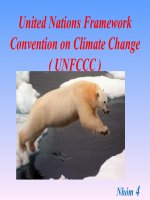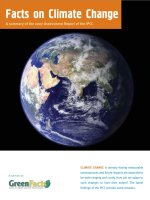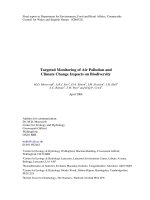- Trang chủ >>
- Khoa Học Tự Nhiên >>
- Vật lý
historical perspectives on climate change sep 1998
Bạn đang xem bản rút gọn của tài liệu. Xem và tải ngay bản đầy đủ của tài liệu tại đây (11.14 MB, 209 trang )
on
Climate Change
Historical Perspectives
This page intentionally left blank
HISTORICAL
PERSPECTIVES
ON
CLIMATE
CHANGE
James Rodger Fleming
New
York Oxford
Oxford
University Press
1998
Oxford
University Press
Oxford
New
York
Athens Auckland Bangkok Bogota Buenos Aires Calcutta
Cape Town Chennai
Dar es
Salaam Delhi Florence Hong Kong Istanbul
Karachi
Kuala Lumpur Madrid Melbourne Mexico City Mumbai
Nairobi Paris Singapore Taipei Tokyo Toronto Warsaw
and
associated
companies
in
Berlin
Ibadan
Copyright
©
1998
by
Oxford
University Press, Inc.
Published
by
Oxford University Press, Inc.
198
Madison Avenue,
New
York,
New
York, 10016
Oxford
is a
registered trademark
of
Oxford University
Press
All
rights
reserved.
No
part
of
this publication
may be
reproduced,
stored
in a
retrieval system,
or
transmitted,
in any
form
or by any
means,
electronic, mechanical, photocopying, recording
or
otherwise,
without
the
prior permission
of
Oxford University Press.
Library
of
Congress Cataloging-in-Publication Data
Fleming, James Rodger.
Historical perspectives
on
climate change
/
James Rodger Fleming,
p.
cm.
Includes bibliographical references
and
index.
ISBN
0-19-507870-5
1.
Climatic changes—Europe—History.
2.
Climatic changes—United
States—History.
3.
Global environmental change—History.
I.
Title.
QC981.8.C5F45 1998
306.4'5—DC21
97-22545
98765432
Printed
in the
United
States
of
America
on
acid-free paper
To
the
Rodger, Fleming,
and
Yamato
families
The
one
constant certainty
in the
world
is
change.
—I
Ching.
This page intentionally left blank
Preface
This book provides historical perspectives
on
climate
and
climatic
changes
from
the
Enlightenment
to the
late-twentieth century. What
have people understood, experienced,
and
feared
about
the
climate
and its
changes?
How
have privileged
and
authoritative positions
on
climate been established?
By
what paths have
we
arrived
at our
cur-
rent state
of
knowledge
and
apprehension? What does
a
study
of the
past have
to
offer
to the
interdisciplinary investigation
of
environmen-
tal
problems?
This
project
began
as a
study
of
climatic change ideas
in
early
America.
My
research
led me to
Enlightenment sources
in
Europe
and
to
the
accounts
of
early explorers
and
settlers
in the New
World.
The
study quickly branched into
the
development
of
international net-
works
of
observation,
the
scientific transformation
of
climate dis-
course,
and
early contributions
to
understanding terrestrial tempera-
ture changes,
infrared
radiation,
and the
carbon dioxide theory
of
climate.
Global
change views
the
Earth
as an
interconnected system
of
physi-
cal,
chemical,
geological,
biological,
and
human processes.
It
studies
interrelationships
in the
Earth system
and
changes
and
rates
of
change
of
environmental variables.
It
poses
new
kinds
of
interdisciplinary
viii
PREFACE
questions
and
proffers
new
types
of
answers.
At its
best
it
challenges
us to
change
our
concepts,
our
behaviors,
and
even
our
values.
It is a
dynamic research
field.
Great
uncertainties exist
in our
scientific
knowledge
of the
Earth
system,
and
there
is
much
to be
learned about clouds,
the
oceans,
the
biosphere, geochemical cycles,
and
other processes. Human behav-
ior
is
also quite varied
and
represents
a
real "wild card"
in the
Earth
system.
One
of
the
human dimensions, however,
the
historical dimen-
sion,
has not
received adequate attention. Historians
can
easily dem-
onstrate that over time, huge changes
in
concepts
and
attitudes have
taken place.
On
time scales ranging
from
decades
to
centuries,
the
rate
of
change
of
climate ideas
is
quite stunning. Ideas
and
apprehensions
may
well
be
changing much
faster
than
the
climate
itself.
Historians
of
science
are
trained
to
examine
major
conceptual
shifts
in our
under-
standing
of
nature. Moreover, newer historiography
has
established
that
major
paradigm
shifts
are not
solely attributable
to
changes
in
science
and
technology
but are due as
well
to
social
and
cultural
factors.
I
have
not
attempted
to
construct
a
complete survey
of
climate
change history, grand narratives being
out of
style
and
fraught
with
problems. Instead,
I
have written
a
series
of
interrelated essays
on
elite
and
popular understanding
of
climate change.
The
book begins with
an
introductory essay
on
three basic meanings
of the
term "apprehen-
sion":
(1)
awareness
or
understanding,
(2)
anticipation
or
dread,
and
(3)
intervention. Subsequent chapters explore
the
climate apprehen-
sions
of
scientists, other intellectuals,
and the
general public
from
the
eighteenth century
to the
late twentieth century. There
are
essays
on
climate
and
culture
in
Enlightenment thought, climate debates
in
early
America,
the
expansion
of
observing systems,
and the
development
of
a
scientific mode
of
climatological discourse. These
are
followed
by
chapters
on
individual scientists
and
writers:
Joseph
Fourier, John
Tyndall, Svante Arrhenius,
T. C.
Chamberlin,
and the
environmental
determinist Ellsworth Huntington.
A
penultimate chapter
on
global
warming
before
1957 examines public awareness
of
climate issues
and the
work
of
individuals such
as G. S.
Callendar, Gilbert Plass,
and
Roger
Revelle.
The
epilogue argues
for a
view
of
global change
and
its
human
dimensions rendered more complete
by the
study
of the
intellectual, social,
and
cultural changes that preceded
the
current
environmental crisis.
Waterville,
Maine
J. R. F.
March
1998
Acknowledgments
This
research
was
supported
hy
grants
from
the
Interdisciplinary
Studies Division
and the
Natural Science Division
at
Colby
College,
an
Andrew
W.
Mellon Fellowship
at the
American Philosophical Soci-
ety
Library,
and a
sabbatical year provided
by
Colby
and
funded
in
part
by a
fellowship
from
the
National Endowment
for the
Humani-
ties.
During
this
time
I was a
visiting scholar
in the
Program
in
Sci-
ence, Technology,
and
Society
at the
Massachusetts Institute
of
Tech-
nology
and a
research associate
with
the
Department
of
History
of
Science
at
Harvard University.
I
conducted archival research
in the
libraries
and
repositories listed
in the
bibliography,
and
worked
in a
number
of
printed collections
including those
of the
American Philosophical Society Library, Bib-
liotheque d'Information, British Library, Harvard University, John
Crerar
Library, Library
of
Congress, MIT, National Oceanic
and
Atmo-
spheric Administration Central Library,
The
Pennsylvania State Uni-
versity,
The
University
of
Arizona, University
of
London,
and
Yale
University.
Without exception,
the
librarians
and
archivists
I
worked
with
were extremely kind,
helpful,
and
knowledgeable. Permission
to
quote
from
manuscript
sources
is
gratefully
acknowledged
from
the
American Philosophical Society Library,
the
Bibliotheque nationale,
X
ACKNOWLEDGMENTS
the
British Library,
the
Library
of
Congress,
the
Royal Institution
of
Great
Britain,
the
Royal Society,
the
Syndics
of
Cambridge University,
the
Trustees
of the
National Library
of
Scotland,
the
University
of
Chicago
Library,
the
U.S. National Academy
of
Sciences Archives,
the
U.S.
National Archives
and
Records Administration,
and
Yale Univer-
sity Library. Permission
to
reproduce figures
was
granted
by the
Con-
troller
of Her
Britannic Majesty's Stationary
Office,
the
heirs
of
Virgil
Partch,
the
Library
of
Congress,
the
Royal Meteorological Society,
Tellus,
and
Yale University Press.
The
following individuals
went
out of
their
way to
make
me
feel
welcome
at
their institutions: William Deiss
and
Libby Glenn
at the
Smithsonian Institution Archives, William Massa
at
Yale's Sterling
Library,
Mrs.
I. M.
McCabe
at the
Royal Institution
of
Great Britain,
and
Steven
S. R. B.
Smith
at the
Center
of
Historical Studies
at
the
University
of
London.
My
good friend
and
colleague
Roy
Good-
man, curator
of
printed materials
at the
American Philosophical
Society Library, supplied
me
with
references, suggestions,
and
gentle
encouragement.
I
presented preliminary ideas
and
draft
chapters
in
seminars
at the
following
institutions: American Geophysical Union, Boston College,
Boston
University, Colby College, History
of
Science Society, MIT,
McGill
University, Penn State University, Smithsonian Institution,
the
University
of
Arizona,
and the
University
of
Washington.
I
am
extremely
grateful
for the
many helpful comments
and
sug-
gestions given
by my
friends
and
colleagues. These
include
Leo
Marx,
Jill
Ker
Conway, Kenneth Keniston,
and the
many participants
in the
MIT
faculty
workshops
on
"Humanistic Perspectives
on
Atmospheric
Change"
and
"The Humanities
and the
Environment" that
ran
from
1991
to
1995. Eugene Skolnikov,
Roz
Williams, Charlie Weiner, Merritt
Roe
Smith, Barbara Rozenkrantz, Larry Buehl, Timothy Weiskel, James
Risbey,
and Sam
Bass Warner, Jr., come immediately
to
mind.
I
thank
them
all for
their support, encouragement,
and
sound advice. John
A.
Button arranged
for me to
teach
a
seminar
on
global change history
in
the
Earth System Science Center
at
Penn State University.
E.
Philip
Krider
was the
host
of my
valuable visits
to the
University
of
Arizona
where
I was a
guest
of the
Institute
for the
Study
of
Planet Earth
and
the
Institute
of
Atmospheric Physics.
He
offered
me
encouragement
and
sound advice
as the
manuscript neared completion. Many
of the
ideas
in the
book were also aired
in my
seminars
on the
history
of
global environmental change
at
Colby College.
My
students expanded
my
horizons
and
provided
me
with
many
new
insights.
My
very special, hard-working research assistants
at
Colby
filed,
ab-
stracted, editorialized,
and
commiserated with
me on
innumerable
drafts.
They
are
Jodi Adams, Heather Davidson, Michael Gerard, Kristin
Girvin, Simone Kaplan, Bethany
Knorr,
Amy
Lyons, Dmitry Mironov,
Gretchen Skea,
and
Dave Thibodeau. Together Amy, Beth, Simone,
and
ACKNOWLEDGMENTS
xi
Heather read
the
final manuscript. Alice Ridky,
the
department secre-
tary,
assisted cheerfully
in
many stages
of the
project. Grace
von
Tobel
helped prepare
the
final manuscript. Special thanks
are
also
due the
Colby
librarians, especially Susan Cole,
the
science librarian,
and
"Sunny"
Pomerleau,
the
interlibrary loan
officer.
It was my
editor, Joyce
Berry
at
Oxford
University Press,
who
suggested that
I
turn
a
confer-
ence
paper into
a
proposal
and
then
a
book.
Her
confidence
in me was
unwavering, even when
my
progress
was
glacial. Robert Milks
and the
staff
at the
press provided superb editorial support.
Through
it
all,
I was
sustained
by the
love
of my
wife,
Miyoko,
and
our
children, Jamitto
and
Jason.
This page intentionally left blank
Contents
Introduction:
Apprehending
Climate Change
3
1
Climate
and
Culture
in
Enlightenment Thought
11
2 The
Great Climate Debate
in
Colonial
and
Early America
21
3
Privileged
Positions:
The
Expansion
of
Observing Systems
33
4
Climate Discourse Transformed
45
5
Joseph Fourier's Theory
of
Terrestrial
Temperatures
55
6
John Tyndall, Svante Arrhenius,
and
Early Research
on
Carbon Dioxide
and
Climate
65
7 T. C.
Chamberlin
and the
Geological Agency
of
the
Atmosphere
83
8 The
Climatic Determinism
of
Ellsworth Huntington
95
9
Global Warming?
The
Early
Twentieth
Century
107
10
Global Cooling, Global Warming: Historical Dimensions
129
Notes
139
Bibliography
167
Index
190
This page intentionally left blank
Historical
Perspectives
on
Climate Change
This page intentionally left blank
Introduction
Apprehending Climate Change
This
most excellent
canopy,
the
air,
look
you, this
brave
o'erhanging
firmament,
this
majestical
roof
fretted
with
golden
fire,
why,
it
appears
no
other
thing
to me
than
a
foul
and
pestilent
congregation
of
vapours.
What
a
piece
of
work
is a
man!
how
noble
in
reason!
how
infinite
in
faculty!
in
form
and
moving
how
express
and
admirable!
in
action
how
like
an
angel!
in
apprehension
how
like
a
god!
—Shakespeare,
Hamlet,
act 2,
scene
2.
Apprehensions have been multiplying rapidly that
we are
approach-
ing a
crisis
in our
relationship with nature,
one
that could have
po-
tentially catastrophic results
for the
sustainability
of
civilization
and
even
the
habitability
of the
planet. Much
of the
concern
is
rightfully
focused
on
changes
in the
atmosphere caused
by
human activities.
Only
a
century
after
the
discovery
of the
stratosphere,
only
five
de-
cades
after
the
invention
of
chlorofluorocarbons
(CFCs),
and
only
two
decades
after
atmospheric chemists warned
of the
destructive nature
of
chlorine
and
other compounds,
we
fear
that
ozone
in the
strato-
sphere
is
being damaged
by
human activity. Only
a
century
after
the
first
models
of the
carbon cycle were developed, only three decades
after
regular
CO
2
measurements began
at
Mauna
Loa
Observatory,
and
only
two
decades
after
climate modelers
first
doubled
the
CO
2
in a
computerized
atmosphere,
we
fear
that
the
Earth
may
experience
a
sudden
and
possibly catastrophic warming caused
by
industrial pol-
lution. These
and
other environmental problems were brought
to our
attention mainly
by
scientists
and
engineers,
but the
problems belong
to
us
all. Recently, policy-oriented social scientists, public
officials,
and
diplomats have turned their attention
to the
complex human
di-
mensions
of
these issues.
New
interdisciplinary
and
multidisciplinary
3
4
INTRODUCTION
collaborations
have arisen between scientists
and
policymakers
to
examine
the
extremely challenging issues raised
by
global
change.
1
There
has
been
a
rising tide
of
literature—scholarly
works,
new
jour-
nals,
textbooks, government documents, treaties, popular
accounts—
some quite innovative, others derivative
and
somewhat repetitious.
This
has
resulted
in
growing public awareness
of
environmental
is-
sues,
new
understanding
of
global change science
and
policy, wide-
spread concerns over environmental risks,
and
recently formulated
plans
to
intervene
in the
global environment through various
forms
of
social
and
behavioral
engineering,
and
possibly
geoengineering.
Global
change
is now at the
center
of an
international agenda
to
under-
stand, predict, protect,
and
possibly control
the
global environment.
The
changing nature
of
global
change—the
historical
dimension—
has
not
received adequate attention. Most writing addresses current
issues
in
either science
or
policy; much
of it
draws
on a few
authorita-
tive scientific statements such
as
those
by the
Intergovernmental
Panel
on
Climate Change
(IPCC);
almost none
of it is
informed
by
historical
sensibility.
In the
"race
to
save
the
planet"
(to
borrow
from the PBS
film
series
of the
same
name),
most historians
didn't
even
go to the
track.
Some
scientists work
in
collaboration with historians,
archaeologists,
and
anthropologists
to
reconstruct
the
temperature
and
rainfall
records
of
the
past. Examples
of
this include
the
publications
of
Raymond
Bradley
and
Philip Jones
and the
work
of the
Tree-Ring
Lab at the
Uni-
versity
of
Arizona. Some historians
use the
available
scientific
data
to
explore
the
effect
of
climate variations
on
past societies.
The
books
of
Emmanuel
Le Roy
Ladurie
and H. H.
Lamb immediately come
to
mind.
2
This
book
is
related
to but
distinct
from
such
works
on
climate
recon-
struction
and
climate history.
I am
interested
in the
history
of
climate
change theories
and
ideas, that
is, how
global change
can be
studied
as
a
subset
of the
history
of
science
and
technology.
The
history
of
global environmental change draws
in
part
on the
his-
tories
of
particular sciences such
as
astronomy, chemistry, computer
science, geography, geology, meteorology, paleontology,
and
physics;
and in
part
from
much broader historical currents.
All of
these
fields
have been examined
before,
at
least
to
some extent,
by
historians
with
particular disciplinary interests. With global change
as the new
focus,
however,
a new
interdisciplinary picture begins
to
emerge that includes
both elite
and
popular apprehensions. What have people experienced,
learned, feared about climate change
in the
past?
How
have they inter-
vened?
By
what path have
we
reached
the
current state
of
climate
ap-
prehension?
Can we
possibly claim
to
have
a
complete understanding
of
climate change
and
other environmental problems
if
we
ignore
their
intellectual, social,
and
cultural history?
How
then shall
we
understand
the
history
of
climate change
and
relate
it to
contemporary concerns?
A
central metaphor that
has
helped
me
organize
the
massive amount
of
material
on
this
subject
is the
term
INTRODUCTION
5
"apprehension."
Several senses
of the
word
are
intended:
(1)
aware-
ness
or
understanding,
(2)
anticipation
or
dread,
and (3)
intervention.
3
I
wish
to
understand
how
people became aware
of
climate change,
how
scientists
and the
general public understood
the
issues,
how the
study
of
the
atmosphere changed over time,
and the
social
and
cultural
implications
of
these
changes. Throughout
the
book
I
will
also exam-
ine
popular awareness
of
environmental risks
and
modes
of
climate
intervention, whether proposed
or
practiced.
Awareness
and
Understanding
Fix not too
rashly
upon
your
first
apprehensions.
—Richard
Baxter
(1670),
Oxford
English Dictionary
(O.E.D.)
In
pursuing historical research
on
climate change,
I
have
had to ask
several crucial questions.
How do
people (scientists included) gain
awareness
and
understanding
of
phenomena that cover
the
entire
globe,
and
that
are
constantly changing
on
time scales ranging
from
geological
eras
and
centuries
to
decades, years,
and
seasons?
How
was
this
accomplished
by
individuals immersed
in and
surrounded
by
the
phenomena?
How
were privileged positions created
and de-
fined?
The
answers
are
varied
and
worthy
of
extended
reflection.
Without
the
ability
to
observe
the
climate system
in its
entirety
(as
an
astronomer might view
a
star
or
planet)
or to
experiment
on it
directly
(as a
chemist might view
a
reaction),
how did
scientific
understanding
of it
emerge? What
are the
historical relationships
among
the
numerous
and
quite
varied
theories
of and
ideas
about
climatic change?
In
addition
to
their scientific
bases,
how
were they
related
to
more general popular perceptions
and
(mental)
apprehen-
sions
of the
environment?
One
approach, popular
in the
eighteenth century,
was
through
appeals
to
authority—references
to
historical literature,
first
impres-
sions
of
explorers,
or the
memory
of the
elderly. This
was the
rhetori-
cal
strategy
of the
Enlightenment
and
early American writers
who
wanted
to
support
a
particular theory
of
cultural development
or de-
cline (see chapters
1 and 2).
Another
way of
approaching
the
issue
was to
collect massive
amounts
of
meteorological data over large areas
and
extended time
periods
in the
hope
of
deducing climatic patterns
and
changes. Indi-
vidual observers
in
particular locales
dutifully
tended
to
their
jour-
nals,
and
networks
of
cooperative observers gradually extended
the
meteorological
frontiers.
Beginning
in
earnest
in the
nineteenth cen-
tury,
scientists tabulated, charted, mapped,
and
analyzed
the
obser-
vations
to
provide climatic inscriptions. This process profoundly
6
INTRODUCTION
changed climate discourse
and
established
the
foundations
of
the
sci-
ence
of
climatology (see chapters
3 and 4).
A
third
approach
to
privileged knowledge
was to
establish
from
first
principles what
the
climate ought
to be and how it
ought
to
change.
Joseph
Fourier, John Tyndall, Svante
Arrhenius,
T. C.
Chamberlin,
and
many
others—all
from
different
eras,
and all in
their
own
ways—en-
gaged
in
such speculative
and
theoretical practices (see chapters
5, 6,
and 7).
These approaches, drawn
from
physical, mathematical, geologi-
cal,
and
astronomical evidence
and
principles, tended
to be
most satis-
fying
to
those scientists working
within
a
particular disciplinary per-
spective. Most scientists
had one
favorite
causal mechanism
and
only
grudgingly
admitted other possible secondary causes
of
climate change.
A
final
approach
to
privileged climate knowledge
has
been through
technology.
In
part
with
the
invention
and
standardization
of
meteoro-
logical
instruments,
the
networking
of
meteorological observers,
and
the
development
of
statistical analysis,
a
picture (albeit abstract
and
imperfect)
of the
climatic aspects
of
locations
and
regions emerged
in
the
second
half
of the
nineteenth century. This
fuzzy
image
of the
climate
has
been rendered three-dimensional
in the
twentieth century
by
the
development
of
upper-air observations, extended into
the in-
definite
past
by
paleoclimatic techniques, and,
finally,
globalized
in
the era of
satellite remote sensing. Many scientists today
are
working
on
links between remote sensing
and
more sophisticated climate
models. They
are
hoping, through advances
in
technology,
to
provide
new
privileged positions.
For
most scientists
the
goal
is
better under-
standing
of
climate;
for
some
it is
also prediction
and
control.
Anticipation
and
Dread
The
bare
fears
of
such things
and
apprehensions
of
their approach.
—Robert
Sanderson
(1648),
O.E.D.
A
second meaning
of
apprehension
is
related
to the
question
of
popular
fears
of
climate change, including crop
failures,
volcano weather,
and
apocalyptic visions
of the
return
of the
deadly glaciers
or
perhaps global
warming. What
did the
populace
fear
about
the
heavens? What
did
they
anticipate might happen?
How was
their
awareness
and
understanding
of
climate linked
to
their anxieties?
Terrifying
possibilities
confronted
people
whose livelihood,
food
supply,
and
health
were
tied
closely
to
the
weather. Everyone
feared
harsh
winters, spring
floods,
summer
drought,
and
harvest storms that could result
in
crop
failures
and
fam-
ine. Exposure
to
miasmas, night airs,
or
getting chilled
"to
the
bone" could
mean
a
sudden downturn
in
health
and
even death.
As
Yi-fu
Tuan
ob-
served
in his
book Landscapes
of
Fear,
"To
apprehend
is to
risk appre-
hensiveness.
If
we did not
know
so
much,
we
would have less
to
fear."
4
INTRODUCTION
7
For
much
of
history, people
feared
that
the
powers
of
evil were
active during
inclement
weather. Processions, prayer vigils,
and the
ringing
of
church bells were used
to
ward
off
the
"prince
of the
powers
of
the
air," identified
as the
devil
and his
minions. Eighteenth-century
divines frequently dwelt
on
God's providence manifest
in
specific
events
such
as
stormy winds, thunderclaps, drought,
and
rain.
In
per-
haps
the
most
famous
sermon
of
this
genre,
"The
Voice
of God in
Stormy
Winds,"
preached
on
April
9,1704,
Increase Mather outlined
the
natu-
ral
origins
of
storms
but
argued that secondary causes
can be
overruled
by
God.
By the end
of
the
century, however,
scientific
discoveries were
supposed
to
have waylaid such superstitious
fears,
and
Franklin's light-
ning rods
comforted
and
protected both believers
and
skeptics.
During
the
Enlightenment, some
philosophes
believed that culture
was
determined,
or at
least strongly shaped,
by
climate. They warned
of
cultural decline attending environmental change, both
in the
fall
of
empires
and the
decline
of
creative genius
in
certain nations
and
periods. According
to
this theory, Europeans leaving their native lands
to
establish colonies
in the
cold
and
damp
New
World
or in the hot
and
humid
tropics
did so at
great personal risk, both
to
themselves
and
their descendants.
Even
in
more "enlightened" times,
fears
of a
year
without
a
summer,
a
return
to an ice age
(even
a
"little"
one),
or
a
secularly cooling globe have generated calls
for
climate prediction
and
control. Although
today's
climate concerns
are
dominated
by the
fear
of
global warming,
for
most
of
human history
the
dominant sen-
timent
has
been
that
"warmer
is
better."
There
are
other, perhaps more
fundamental
fears
related
to a
rift
in
the
social
fabric
caused
by
climatic change.
Nico
Stehr,
a
contempo-
rary
sociologist,
fears
that climate change
may
destroy "age-old envi-
ronmental
representations"
that
are
fundamental
to
social
and
cultural
cohesiveness.
As
others predicted
in
connection with
the
fear
of
nuclear weapons
in
the
1960s, Stehr points
to the
possibility
of
social
breakdowns
due to the
interruption
of
natural rhythms.
On a
more
prosaic level, even
the
United Nations
has
warned that adverse cli-
matic
impacts "may weaken governments
at a
time when they
will
need
all of
their resources
to
respond
to
climate
change."
5
Intervention
and
Control
A
warrant
for his
apprehension
was
obtained.
—Chambers'
Edinburgh
Journal
(1881),
O.E.D.
A
third task, related
to the
first
two,
is to
investigate modes
of
arrest-
ing
(apprehending)
or
otherwise
intervening
in
climate change,
whether
by big
technical
fixes
or by
social engineering
of
human
be-
8
INTRODUCTION
havior.
In
eras other than
our
own,
the
climate
has
heen
perceived
as
amenable
to
human
impact
or
intervention.
The
ancient Greeks inter-
vened
in the
natural world
on a
modest scale
by
diverting streams
and
draining marshes. Early modern environmental determinists thought
human settlement
had
caused
a
gradual warming
of the
European
continent. Settlers
in the New
World engaged
in
self-conscious,
if
ineffective,
efforts
to
modify
and
"improve"
the
climate through clear-
ing the
forests
and
cultivating
the
lands.
At the
turn
of the
twentieth
century,
the
climatic
effects
of
industrial
emissions—especially
the
rising
use of
coal—came
under some scrutiny. Most people, however,
thought increasing carbon dioxide levels
in the
atmosphere would
have
no
effect
at
all. Some believed
it
could possibly have
a
long-term
beneficial
effect
on
climate
by
stimulating plant growth
and
prevent-
ing
a
return
of the
deadly glaciers. Since
the
1950s,
new
understand-
ings
of
global change phenomena have
led
some
to
conclude that cli-
matic change
can be
predicted
and
that climate
(or at
least human
impact
on the
climate) might even
be
controlled.
Climate
apprehensions—awareness
and
understanding,
fear,
and
intervention—are
all
interrelated.
In
every
era,
scientists have created
climate narratives, theories,
and
reconstructions
in
conformity
with
their personal experiences, experimental
techniques,
technical capaci-
ties,
and
philosophical preferences. Some theories have been more
convincing
than others; some have raised public awareness; some have
generated
serious social concerns;
and
some have indicated
the
need
for
concerted action.
Structure
and
Purpose
Chapter
1
examines
the
notion that changes
in
climate influenced
culture,
society,
and
even individuals. Early statements
to
this
effect,
found
in the
work
of
Jean Bodin
and
others,
had
been developed into
full-fledged
theories
of
climatic determinism
by the
mid-eighteenth
century
by
Abbe
Jean-Baptiste
Du Bos and his
famous
disciples.
Du Bos
believed that
the
climate
of
Europe
had
moderated since Roman times
due to the
gradual clearing
of the
forests
and the
spread
of
cultiva-
tion,
and
that vast cultural displacements
had
resulted.
The
Ameri-
can
climate
was
thought
by
some
to be
undergoing similar
but
much
more
rapid
and
dramatic changes.
The
theory that human
efforts
might improve
the
climate
of the New
World
fueled
a
significant
debate
in
colonial
and
early America.
This
debate
is
examined
in
chapter
2.
Colonists
and
patriots
hoped
that
by
pushing back
the
wilderness
and
displacing
"primitive"
native cul-
tures,
a
flourishing civilization might take root
on
American soil.
Expectations
that
the
American climate
was
becoming warmer, less
variable,
and
healthier swelled
the
national pride
and
swayed
the
INTRODUCTION
9
practical decisions
of
yeoman farmers. This vision
was an
integral
component
of an
emerging Republican national ideal.
Early
Ameri-
cans, hoping
to
document climatic changes,
faithfully
kept weather
diaries
and
compiled observations over large expanses
of the
country.
Chapter
3
deals
with
the
growth
of
observing systems
and the de-
velopment
of
national weather services
in
many nations.
As the
sys-
tems expanded, they generated massive amounts
of
data
and
provided
privileged perspectives
on the
climate
for a new
generation
of
theo-
rists. Chapter
4
discusses
the
resolution
of
the
American debate
in
favor
of
climate stability.
It
illustrates
how the
evolution
of
meteorological
observing
systems contributed
to a
radical transformation
of
climate
discourse
and the
emergence
of a
recognizably modern climatology.
These
four
chapters illustrate
the
cultural situatedness
and
historical
contingency
of our
climate knowledge.
Chapter
5
investigates Joseph Fourier's theory
of
terrestrial tempera-
tures, beginning
with
a
review
of
recent citations
to his
climate work.
Fourier,
who
aspired
to be the
"Newton
of
heat,"
was
passionately
engaged
in his
theoretical
and
experimental studies.
In his
archaic
system,
the
"temperature
of
space"
was
more important than
the
"greenhouse
effect"
in
controlling
the
Earth's heat budget.
The
follow-
ing
chapter treats John Tyndall,
an
accomplished experimenter
who
made molecules dance
in his
apparatus,
and
Svante
Arrhenius,
a
Nobel
Prize-winning
chemist whose many scientific interests included cos-
mic
physics. Among
his
many discoveries, Tyndall
was
able
to
dem-
onstrate that atmospheric trace gases might have significant radiative
effects
on
weather
and
climate. Arrhenius's quest
for an
explanation
of
the
onset
of ice
ages
and
interglacial periods
led him to
construct
a
crude model
in
which variations
of
atmospheric
CO
2
concentration
had a
significant
effect
on the
heat
budget
and
surface
temperature
of
the
planet, especially
in
high latitudes.
Later
in
life,
Arrhenius specu-
lated
on the
potentially
beneficial
role that industrial carbon emissions
might have
on the
climate. Chapter
7
explores
the
life
and
work
of
T.
C.
Chamberlin,
a
glacial
geologist
who
developed
an
interest
in in-
terdisciplinary earth science.
His
work
on the
geological
agency
of the
atmosphere informed
his
understanding
of the
carbon cycle
and led
him to
propose
a new
theory
of the
formation
of the
Earth
and the
solar
system.
The
chapter
on
Ellsworth Huntington
is
included
to
illustrate
the
pitfalls
of
environmental determinism.
His
racially biased work
on
civilization
and
climate
and his
crude
efforts
to
link human
perfor-
mance directly
to
changes
in the
weather have been summarily
re-
jected.
Yet he was a
practitioner
of a
perennial philosophy
of
climatic
influence,
and his
errors
and
excesses serve
as an
example
of
how not
to
study
the
human dimensions
of
global change.
Chapter
9
traces issues related
to
global warming
in the
first
six
decades
of the
twentieth
century.
It
begins
with
the
demise
of the old
10
INTRODUCTION
carbon dioxide theory
of
climate,
as
advocated
by
Arrhenius
and
Chamberlin. Other mechanisms
of
climatic
change—especially
changes
in
solar luminosity, atmospheric transparency,
and the
Earth's orbital
elements—received
more attention.
As
temperatures reached
an
early-
twentieth-century maximum
and
industrial carbon emissions contin-
ued to
rise,
a new
carbon dioxide theory emerged
that
was
based
on
the
contributions
of
scientists such
as G. S.
Callendar, Gilbert
Plass,
and
Roger
Revelle.
The
book concludes with
a
chapter that examines
recent episodes
of
global cooling
and
global warming.
Global
change
is a
pluralistic
and
dynamic enterprise.
Yet its
sci-
entific
and
human dimensions
can be
further
enhanced
by the
study
of
history.
If
these essays expand
the
horizons
of the
field
in any
way—
if
they raise
any new
issues, provide
any new
insights,
or
provoke
any
new
controversies—I
will
deem
the
effort
a
success.









